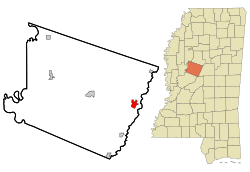Durant, Mississippi facts for kids
Quick facts for kids
Durant, Mississippi
|
||
|---|---|---|

Train station in Durant
|
||
|
||

Location of Durant, Mississippi
|
||
| Country | United States | |
| State | Mississippi | |
| County | Holmes | |
| Area | ||
| • Total | 2.26 sq mi (5.86 km2) | |
| • Land | 2.24 sq mi (5.80 km2) | |
| • Water | 0.02 sq mi (0.06 km2) | |
| Elevation | 259 ft (79 m) | |
| Population
(2020)
|
||
| • Total | 2,231 | |
| • Density | 995.98/sq mi (384.59/km2) | |
| Time zone | UTC-6 (Central (CST)) | |
| • Summer (DST) | UTC-5 (CDT) | |
| ZIP code |
39063
|
|
| Area code(s) | 662 | |
| FIPS code | 28-20500 | |
| GNIS feature ID | 0669521 | |
| Website | https://www.cityofdurantms.com/ | |
Durant is a city in Holmes County, Mississippi, United States. It is located near the Big Black River. The city was founded in 1858. It started as a train station on the Mississippi Central Railroad. This railroad later became part of the Illinois Central.
Durant was named after Louis Durant. He was a Choctaw chief who lived in this area. In the 1830s, the United States government moved many Choctaw people, including Louis Durant, to a new area west of the Mississippi River.
In 2020, the city had a population of 2,231 people. About 3 miles from Durant is the Castalian Springs Hotel. In 2020, people believed it was the only old spa building left in Mississippi. Many years ago, people thought the natural springs there had healing powers.
Contents
History of Durant
Early Days and Plantations
The Choctaw are a Native American tribe. They lived in much of Mississippi for thousands of years. After the Choctaw moved from their lands in the 1830s, more European Americans came to the area. They started large cotton farms called plantations. Before the Civil War, this area was known for its many plantations.
These large farms were built near rivers. This was because rivers were used for transportation. Many African Americans were forced to work on these plantations. Today, most of the people in Holmes County are African American.
The Castalian Springs Hotel
The Castalian Springs Hotel is a two-story wooden building. It was part of a resort with natural mineral springs. It is located about 3 miles west of Durant. During the Civil War, the hotel was used as a hospital. It helped treat many soldiers who were hurt in the Battle of Shiloh in 1862. Wounded soldiers were brought by train to Durant. Then, they were taken by wagon to the hotel. About 90 Confederate soldiers died there and were buried nearby. New gravestones were placed for them in the 1990s.
After the war, the hotel was used for different things. First, it was a private school for girls. Later, it became a camp for the state YMCA. It was also used as a camp to train missionaries. For some years, the hotel was empty. Around 2020, two brothers bought it. They have used it for church events. They might also turn part of it into a hunting camp. This hotel is thought to be the only mineral springs resort building still standing in Mississippi.
Durant in the 20th Century
Around 1890, new laws were passed in Mississippi. These laws made it very hard for African Americans to vote or have equal rights. These laws were called "Jim Crow" laws. Many African Americans moved away from the state during the Great Migration. They hoped to find better opportunities elsewhere. But many who stayed in Holmes County worked hard to get their rights back. They wanted to register and vote.
In 1935, a young woman named Hazel Brannon Smith bought the local newspaper, the Durant News. She became its editor and publisher. She also bought other small newspapers later on. Hazel Brannon Smith was one of the first journalists to write positive stories about the African-American community. She also became famous for her writings about the civil rights movement. In 1964, she was the first woman to win the Pulitzer Prize for Editorial Writing.
Today, the Durant area is still mostly rural. It has a lot of farms. However, modern farming uses machines, so fewer workers are needed. Many people have left the area. The old brick train station in Durant is being restored. It will be used for new purposes. This is part of an effort to bring more visitors to the area.
Geography of Durant
Durant is located at 33°4′35″N 89°51′23″W / 33.07639°N 89.85639°W. The city has a total area of about 2.2 square miles (5.8 square kilometers). Most of this area is land. A small part, about 0.04 square miles (0.06 square kilometers), is water.
People in Durant
| Historical population | |||
|---|---|---|---|
| Census | Pop. | %± | |
| 1870 | 375 | — | |
| 1880 | 724 | 93.1% | |
| 1890 | 1,259 | 73.9% | |
| 1900 | 1,766 | 40.3% | |
| 1910 | 1,881 | 6.5% | |
| 1920 | 1,870 | −0.6% | |
| 1930 | 2,480 | 32.6% | |
| 1940 | 2,510 | 1.2% | |
| 1950 | 2,311 | −7.9% | |
| 1960 | 2,617 | 13.2% | |
| 1970 | 2,752 | 5.2% | |
| 1980 | 2,889 | 5.0% | |
| 1990 | 2,838 | −1.8% | |
| 2000 | 2,932 | 3.3% | |
| 2010 | 2,673 | −8.8% | |
| 2020 | 2,231 | −16.5% | |
| U.S. Decennial Census | |||
Durant's Population in 2020
| Race | Num. | Perc. |
|---|---|---|
| White | 207 | 9.28% |
| Black or African American | 1,964 | 88.03% |
| Native American | 1 | 0.04% |
| Other/Mixed | 42 | 1.88% |
| Hispanic or Latino | 17 | 0.76% |
In 2020, there were 2,231 people living in Durant. There were 886 households and 644 families.
Durant's Population in 2010
In 2010, there were 2,673 people living in the city. The population density was about 1,316 people per square mile. The people living in Durant were mostly African American (85.29%). About 13.80% were White. About 33.9% of households had children under 18. The average household had about 2.68 people. The median age in the city was 32 years old. About 31.6% of the population was under 18. The median income for a household was $19,659. About 35.1% of the population lived below the poverty line.
Education in Durant
The Holmes County Consolidated School District serves the city of Durant. This district runs Durant Elementary School (for grades K-8). It also operates Holmes County Central High School near Lexington.
Before 2018, Durant had its own school district. But in 2016, the Governor of Mississippi signed a bill. This bill combined the Durant district with the Holmes County district. So, since July 1, 2018, they are one district.
In 2018, the school board decided to move high school students from Durant to Holmes County Central High School. Some people in the area did not agree with this decision.
Notable People from Durant
- John Howell – A civil rights activist.
- Minerva Hamilton Hoyt – Born near Durant, she later worked to protect deserts in California.
- Jimmy W. "Jimi" Jamison – A musician, known as the lead singer of the band Survivor.
- Alexander Lane – Born in Durant in 1860. He became an educator, doctor, and politician in Illinois. He was the first African-American male student to graduate from Southern Illinois Normal University.
- Tommy McClennan – A Delta blues singer and guitarist.
- Buford McGee – A former National Football League player.
- Hazel Brannon Smith – A famous journalist and publisher.
- Absolom M. West – A plantation owner and politician who lived near Durant before the Civil War.
See also
 In Spanish: Durant (Misisipi) para niños
In Spanish: Durant (Misisipi) para niños



